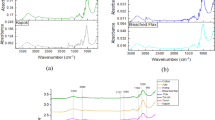Abstract
Near infrared (NIR) spectroscopy has been found to be one of the most important characterization tools for polymeric materials based on comparatively simple NIR-favorable chemical groups (i.e., C–H, O–H, and N–H). This paper focuses on characterizing degradation of cotton cellulosic fibers in a historical textile—‘Curtain Dress’ in the famous movie Gone With the Wind through NIR spectroscopy, and investigating morphological and molecular changes associated with appearance change such as discolorations in the same cotton textiles. In this study, we did on-site testing on the ‘Curtain Dress’ with the Brimrose Luminar 5030 NIR-analyzer and analyzed the NIR spectroscopy results at eight locations where different degrees of discoloration occurred on the dress. The study identified the wavelength bands according to NIR spectral absorbancies of the typical functional groups in cellulosic fibers such as C–H, C–O and O–H stretches, compared the absorbance intensities at three main wavelengths, and investigated discoloration in different areas via principal component analysis. The combination factor scores of the 1st and 2nd principal components, which accounted for 99.09 % variance of vibrations within various groups in a molecule measured through NIR, reflected effectively morphological changes in the fiber’s molecular structure and degrees of discolorations.









Similar content being viewed by others
References
Rodgers J, Beck K (2009) Text Res J 79(8):657–686
Burns DA, Ciurczak EW (2007) Handbook of near- infrared analysis, 3rd edn. CRC Press, Boca Raton
Siesler HW, Ozaki Y, Kawata S, Heise HM (2002) Near-infrared spectroscopy principles, instruments, applications, 1st edn. Wiley-VCH Verlag GmbH, Weinheim
Brown WH, Foote CS, Iverson BL, Anslyn E (2012) Organic chemistry. Brooks/Cole, Cengage Learning, Belmont
Nuance Center, N.U. (2010) What is diffuse reflectance spectroscopy? Retrieved February 12, 2012, from NUANCE: Northwestern University Atomic—and Nanoscale Characterization Experimental Center Web site: http://www.nuance.northwestern.edu/KeckII/Instruments/FT-IR/index.html#FourierTransformInfraredSpectroscopy(FT-IR)
Brenchley JM, Hörchner U, Kalivas JH (1997) Appl Spectrosc 51(5):689–699
Adar F (2012) Analytical vibration spectroscopy—NIR, IR, and Raman, Retrieved April 4, 2012, from http://www.spectroscopyonline.com/spectroscopy/article/articleDetail.jsp?id=745425
Kadolph SJ (2007) Textiles, 10th edn. Pearson Prentice Hall, Upper Saddle River
Boersma F, Brokerhof A, van den Berg S, Tegelaers J (2007) Unravelling textiles. Archetype Publications Ltd, London
Liu YL, Kokot S, Sambi TJ (1998) Analyst 123:1725–1728
Schwaninger M, Rodrigues JC, Fackler K (2011) J Near Infrared Spectrosc 19:287–308
Wust E, Rudzik L (1996) In: Gunzler AMBH, Borsdorf R, Danzer K, Fresenius W, Galensa R, Huber W, Luderwald I, Schwedt G, Tolg G, Wisser H (eds) Highlight ausdem Analytiker-Taschenbuch, Infrarotspektroskopie. Springer, Berlin, p 221
Ali M, Emsley AM, Herman H, Heywood RJ (2001) Polymer 42:2893–2900
Facklera K, Schwanninger M (2010) J Near Infrared Spectrosc 18(6):403–416
Barton FE, Himmelsbach DS (1993) Appl Spectrosc 47(11):1920–1925
Tsuchikawa S, Siesler HW (2003) Appl Spectrosc 57(6):667–674
Fujimoto T, Yamamoto H, Tsuchikawa S (2007) Appl Spectrosc 61(8):882
Watanabe A, Morita S, Ozaki Y (2006) Appl Spectrosc 60(6):611–618
Yonenobu H, Tsuchikawa S (2003) Appl Spectrosc 57(11):1451
Thygesen LG, Lundqvist SO (2000) J Near Infrared Spectrosc 8(3):183
Shenk JS, Workman JJ, Westerhaus MO (2001) In: Burns DA, Ciurczak EW (eds) Handbook of near-infrared analysis. Dekker Inc, New York, p 419
Osborne BG, Fearn T (1998) Near infrared spectroscopy in food analysis. Longman Scientific & Technical, Harlow
Tsuchikawa S, Yamamoto H, Siesler HW (2005) Analyst 130(3):379
Abney C, Festing LC (1881) Philos Trans Royal Soc 172:887
Workman J, Weyer L (2007) Practical guide to interpretive near-infrared spectroscopy, 1st edn. CRC press, Boca Raton
Schimleck LR, Evans R (2004) Holzforschung 58(1):66–73
Smith BC (1998) Infrared spectral interpretation: a systematic approach. CRC Press, Boca Raton
Joseph WE, Bath J (1940) J Am Chem Soc 62(10):2859–2861
J. Yan, N. Villarreal, C. K. Jay and B. Xu (2013) AATCC Rev (in press)
Acknowledgments
The authors wish to gratefully acknowledge the outstanding support of the staff at the Harry Ransom Center at the University of Texas at Austin, in particular Steve Wilson, Curator of Film, and Jill Morena, Assistant Curator of Costumes and Personal Effects, for giving them access to the ‘Curtain Dress.’ They would also like to thank Dr. Cynthia K. Jay from the ‘Historical Textile and Apparel Collection’ at the School for Human Ecology at the University of Texas at Austin for providing cotton samples for comparison testing. Finally, they wish to acknowledge Maggie Houdman and Xiaowen Guo for their assistance with the on site testing.
Author information
Authors and Affiliations
Corresponding author
Rights and permissions
About this article
Cite this article
Yan, J., Villarreal, N. & Xu, B. Characterization of Degradation of Cotton Cellulosic Fibers Through Near Infrared Spectroscopy. J Polym Environ 21, 902–909 (2013). https://doi.org/10.1007/s10924-013-0605-z
Published:
Issue Date:
DOI: https://doi.org/10.1007/s10924-013-0605-z




